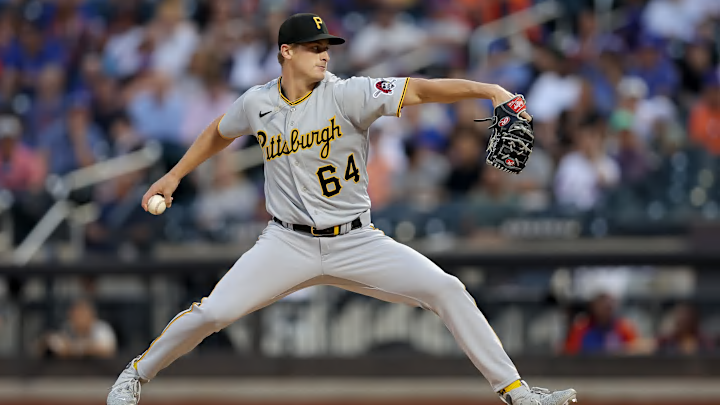What could we expect to see from Quinn Priester in 2024 after a rough first few outings for the Pittsburgh Pirates late into 2023?
The Pittsburgh Pirates’ 2019 first round pick, Quinn Priester made his debut in 2023. It was a mixed bag to say the least. However, Priester will likely have a shot to secure a rotation spot next season, so what could we potentially expect from the top prospect in 2024?
Priester’s minor league numbers were strong. After a rough April, Priester’s final 88.1 innings saw him work to the tune of a 3.16 ERA, 3.64 FIP, and 1.26 WHIP. The right-hander allowed just five home runs and posted a ground ball rate above 50% at 52.4% for the third season in a row.
Priester’s strikeout rate and walk rate were about 2% better than average with a 24.9% strikeout rate and 10.4% walk rate during his final 88.1 innings pitched. Keep in mind that Priester pitched in a league where the average ERA was above 5.00, clocking in at 5.18, and the average WHIP was 1.54.
Priester made his debut, and it could have gone a lot better. He pitched 28.2 innings in his first promotion, but allowed 29 earned runs, 18 walks, and seven home runs. However, the most worrying aspect of his game was the lack of velocity. While Priester was never a flamethrower in the minor leagues, he was able to comfortably sit near the mid-90s. However, in this brief call up, he was only hitting about 91-93 MPH.
The right-hander was sent back down to Triple-A to try and regain the velocity he had lost, and to his credit, was able to get it back. He was sitting closer to 93-95 MPH and topping out just a hair under 97 with his sinker. Priester should use his curveball more often than his slider. He had a whiff rate over 30% with it, and is the best breaking pitch of his arsenal. His sinker also looked good at the majors with +5 run value. His slider also has potential given it’s low active spin rate. He definitely looked better in his recalling, though still had some bumps in the road.
Priester suffered from a ridiculously high 26.7% HR/FB ratio, which should normalize with more playing time. It’s the third highest rate ever posted by a starting pitcher in 50+innings pitched in a non-COVID season. No pitcher has ever posted an HR/FB ratio above 25% in 100+ innings, and the highest HR/FB ratio in 120 innings [itched is 22.8%. You’re not going to convince many people that Priester will continue giving up home runs on fly balls at a higher rate than Barry Bonds hit home runs on fly balls.
HR/FB ratio should be viewed like batting average on balls in play; it’s best to compare it to the player’s average, and not the league average. Priester had a 9% HR/FB ratio in the minors this season, and a career 8.9% HR/FB ratio. Had Priester kept up a 9% HR/FB ratio in the Major Leagues, and pitched the same amount of innings and had the same amount of batted balls allowed, the difference in HR/9 would have an enormous gap of 2.16 to 0.73.
Baseball Savant makes five comparisons to Priester based on velocity and movement, however only two of them pitched more than 50 innings. One is a pretty promising player in Merrill Kelly, who has been one of baseball’s most underrated starting pitchers, and has a 125 ERA+ over the last two seasons, including a 132 ERA+ in 2023, the year they compare Priester to. The other is Brady Singer in 2023, who isn’t coming off a great season, but definitely suffered from some poor batted ball luck, and was pretty good in 2022.
Will Priester be the future ace of the rotation? Probably not. Of course, he only just turned 23 in mid-September, so you can’t rule it out. Some things will definitely benefit Priester in 2024, such as his HR/FB ratio going down. I still think he can be a solid pitcher, someone who can give the Pirates a 3.50-3.80-ish ERA and a decent workload.
